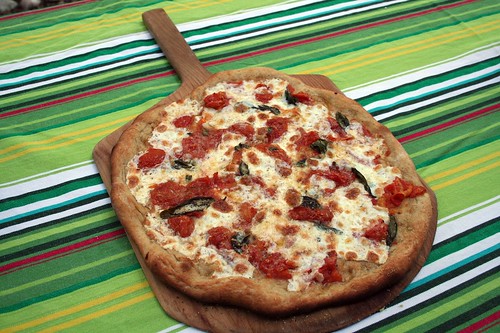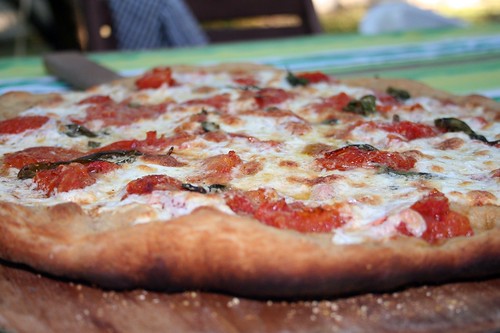If you're devoted to making pizza, you know heat is a big part of success. Our home oven, part of a big dual-fuel setup, uses convection and does a solid 550 degrees without resorting to crazy stuff like hacking the latch for the self-cleaning oven. (Yeah, believe it or not, it's been done.) A colleague with a similar obsession has complained that his oven doesn't reach these temps, and pictures of his pizzas show it. It's gotta be hot and it's gotta cook quickly: you want it brown without the pizza getting dried out. And although heat is a key piece, what every pizza maker knows s/he really wants is a wood-fired pizza oven. Now this is not as absurd a dream as you'd think. There are several models designed for home use (see forno bravo or le panyol, for example), and at least one I've run into is designed so that you can use it indoors--maybe it doubles as an inefficient heat source. However, as technically feasible as a home wood-fired oven is, it feels like a big investment. I can dream, of course.
In the meantime, we recently ran into something called the Big Green Egg. This thing, a kamado-style cooker, generates extremely high heat, serves primarily as a grill, doubles as an oven (and a smoker), and (though still pricey) costs a lot less than a wood-fired oven. Maria and I grill a lot and wanted to incorporate things like spatchcocked chickens into our repertoire, so we decided to give the Big Green Egg a shot.
My first effort at this was relatively successful, with a few problems that leave me opportunities for refining things. I should note that it's relatively easy to get the Big Green Egg up to a mighty 650 degrees and the BGE has available to it accessories (like the "plate-setter") that makes this process pretty straightforward. With the plate setter in place, I went with an American Metalcraft PS1575, a pizza stone made from fire brick and thus much safer for these high heats. (The PS1575 is supposed to be 15.75" in diameter. Mine was a full 16" and may have contributed to some minor damage to my gasket.) This left ample room to slide the pizza onto the stone without losing ingredients over the side. At 650 degrees, the pizza cooked in slightly more than 10 minutes. As you'll see in the two pictures below, this created a nicely cooked crust with a little (and very tasty) burning below, and browned toppings. For this first effort, I stuck with a classic margherita:


This was, without a doubt, the best home pizza crust we've ever done, and considering the number of pizzas we've cooked, that's saying something. The crust was noticeably more flavorful and the whole thing did have a slightly smoky taste. I'll admit that I expected the pizza to be no different from the ones we've cooked in the oven, but I was definitely wrong.
As usual, I won't try to reproduce the wealth of information on the web about cooking a pizza on a Big Green Egg. The very helpful Naked Whiz site does a very nice job covering all elements of cooking pizza on the Big Green Egg, including addressing issues of the size of the pizza stone.
What challenges lie ahead? I've had a hard time getting my BGE over 650 degrees and would like to try a slightly higher temperature. In putting the pizza into the BGE, I need to get in and out a little more quickly to avoid losing temperature. And I'm going to need to explore what the issues are around the gasket burning, a problem that might be related to the size of the stone, but which was just as likely to be a result of the gasket having been poorly installed (and protruding into the BGE).

When I first published this, I got a lot of very positive feedback, sometimes about the pictures of the pizzas, sometimes expressing relief that I was going back to pizza and leaving library issues alone (!), and sometimes with advice (use a nomex gasket, use a really big charge of charcoal, and always 'burp' the BGE when opening it). In fact, over time I've been challenged to get consistently high temps, and I'm pretty sure the elements have something to do with it. Still, the BGE pizzas are lovelier and tastier than anything out of the oven, particularly when it works out as intended.
ReplyDelete